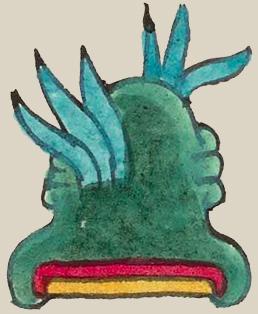Acayocan (Mdz29r)
This is a multicolored painting of the compound glyph for the place name Acayocan.
Stephanie Wood
This compound glyph for the place name Acayocan features acatl), or reeds, the blue-green or turquoise plants growing on the hill or mountain, or tepetl). It is interesting how the reeds are separated into two clumps, somewhat different from the classic representation of the plant and shaped something like feathers. The tepetl sign is not read phonetically as part of the place name, but may imply "place" or "altepetl." Another component that we do not see in the place name is -yo-, from yotl), meaning inalienable possession, or having a certain quality. The locative suffix, -can, is not represented visually, but the hill or mountain provides a semantic representation of the place.
Stephanie Wood
acayucā, puo
Acayocan, pueblo
Stephanie Wood
c. 1541, or by 1553 at the latest
Stephanie Wood
reeds, rushes, canes, mountains, hills, nombres de lugares

aca(tl), reeds, https://nahuatl.wired-humanities.org/content/acatl
-yocan, place where there is a lot of (the preceding noun), https://nahuatl.wired-humanities.org/content/yocan
-yo(tl)-, having that characteristic or quality/inalienable possession, https://nahuatl.wired-humanities.org/content/yotl
-can (locative suffix), https://nahuatl.wired-humanities.org/content/can-2
"Place Full of Reeds" (agreeing with the Berdan & Anawalt translation) [Frances Karttunen, unpublished manuscript, used here with her permission.]
"Place Full of Reeds" (Berdan and Anawalt, 1992, vol. 1, p. 168)
"Lugar Lleno de Caña"
Stephanie Wood
Codex Mendoza, folio 29 recto, https://digital.bodleian.ox.ac.uk/objects/2fea788e-2aa2-4f08-b6d9-648c00..., image 68 of 188.
The Bodleian Libraries, University of Oxford, hold the original manuscript, the MS. Arch. Selden. A. 1. This image is published here under the UK Creative Commons, “Attribution-NonCommercial-ShareAlike 3.0 License” (CC-BY-NC-SA 3.0).




